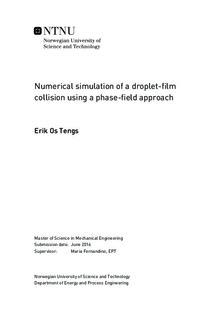Numerical simulation of a droplet-film collision using a phase-field approach
Master thesis
Permanent lenke
http://hdl.handle.net/11250/2401240Utgivelsesdato
2016Metadata
Vis full innførselSamlinger
Sammendrag
Computational Fluid Dynamics is the science of solving the governing equations of fluid motion numerically. Simulating multiphase flow has traditionally been difficult, due to non-uniform fluid properties and challenges in expressing the interfacial forces. A solver developed by the "Thermal Two-Phase Flow Laboratory" at the Norwegian University of Science and Technology, has implemented a phase-field approach in order to model the interface dynamics of multiphase flow. The goal of this thesis is to simulate low energy droplet-film collisions using this solver, and test its performance.
Central to the phase-field approach is the Cahn--Hilliard equation. The equation model phase separation, and in simulations without convection, the solver was proven to be very successful. One and two droplets were simulated with ease. Several guidelines have been developed regarding what numerical resolution is needed to obtain good solutions.
In simulations where the coupled Navier--Stokes and Cahn--Hilliard equations were used to model droplet-film collisions, several errors were uncovered. Most notably was the global mass loss observed for some given problem setups. The solver was also seen to be highly parameter dependent, without discovering the definite underlying solution. Even though mass was not conserved globally, many promising signs were observed with respect to the dynamical behaviour of the collisions. Coalescence, one of the known possible collision outcomes, was obtained, as well as early signs of a bouncing droplet.
A proper mesh refinement and parameter study is recommended as further work in order to correct the errors discovered. Some of the physical behaviour is highly encouraging, and if the issue of mass conservation is corrected, the solver is believed to be a great tool in future multiphase simulations.
